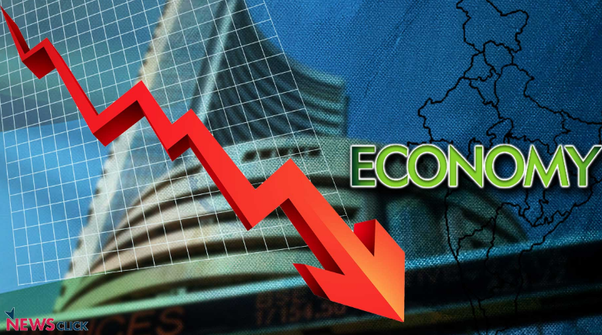In comparison to last year, the Gross Domestic Product of India has declined by 23.9% in the April- June quarter. This reflects the lockdown effect on the Indian economy, as suggested by the GDP numbers that were released on Monday – 31st August 2020.
The statistics show that even before the lockdown was applied, the Indian economy was in a worse situation. It is said to be in the worst ever declaration phases. Except on the 8-basis point blip in the middle of December 2018-March 2019, the GDP growth has rapidly declined for 8 quarters. In March 2018, it was 8.20%, from where it gradually decreased to 3.1% in March 2020.
A major downfall has been observed in the Indian GDP growth since the 2017-18. One of the major drivers of economic growth is the consumption demand. As of 2019-20, the Private Final Consumption Expenditure- PFCE shares 5.7% in the total GDP growth of India. In the March 2020 quarter, this PFCE growth has come down to 2.7%, which is the lowest since the June 2012 quarter. In response to this downfall in the consumption demand, most of the firms have opted for various investment plans. The Gross Fixed Capital Formation-GFCF also faced a contraction at a rapidly increasing rate for 3 continuous quarters, which ends in March 2020. As for the nominal GDP growth observed in 2019-20, has come down to 7.2%, which is so far the lowest since 1975-76! Nominal GDP plays a vital role in the revenue collection. The 2019-20 Union Budget had assumed a 12% nominal growth.
Informal Sector not included
These numbers: however, are prone to a downfall revision as the informal sector numbers are yet to be released.
The numbers from the informal sector are only released at a later stage, says Pranab Sen- former Chief Statistician of India. It has been said that these numbers reflect the effect of the pandemic which has affected economies globally. India is starting a V-shaped recovery since the lockdown has been lifted, suggests CEA Krishnamurthy Subramanian from the Ministry of Finance.
The lockdown effects
In the Apr-June quarter, India’s GDP growth had declined by 23.9%, compared to last year’s quarter. The country was under a complete lockdown from the month of April to May in 2020. This suggests that the effects of lockdown on the Indian economy are worse than expected. A decline of 19.2% was expected after the Bloomberg poll that constituted of 15 economists.
Major effects have been observed in the non-farm economy as well as the government sectors. The Gross Value Added-GVA that measures the production values, reduced by 22.8%. the expenditure side number also decreased gradually, that points to the fact that consumption and investment-both faced a major downfall as an effect of lockdown. PFCE decreases by 26.7%, a 47% decline in the GFCF, and a 16.4% downfall in the Government Consumption Expenditure Growth – all are a result of the lockdown effect on the Indian economy, mainly the non-farm sectors. The only growth observed during this period is in the agricultural department, which observed a 3.37% increment. These numbers are still subject to change and are expected to decline further because the informal sector numbers have not been added yet.
As a result of the lockdown, recovery was observed by the month of June 2020. This recovery rate, however, flattened soon in July when the lockdown was lifted. The little growth in GDP after June was probably because of the increased consumer demand due to the April-May lockdown. The Purchasing Managers Indices (PMI) suggest that a recovery was observed during the month of June. This index of the 8-core sector came down at a gradual speed from 13% in June to 9.6% in July.
However, a major fall-off is observed in the consumer sentiment since the lockdown restrictions were lifted, but the infection rate kept on increasing in India. Taking into consideration the recent RBI survey conducted in July, consumer confidence suggests a downfall in the levels of consumer sentiments. This reflects that the government needs to take quick actions in terms of their revenue collection policies. This cannot be done by the State government as they must face the challenge of bearing the burden of a pandemic that has significantly impacted the revenue collection.





